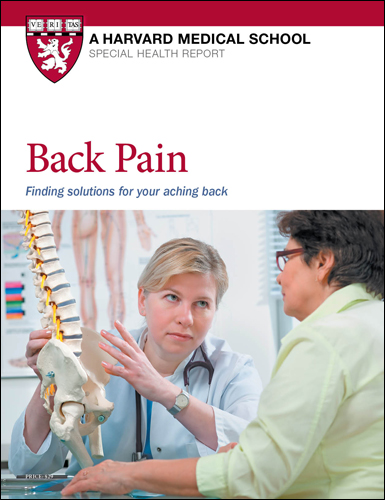Help for your aching back
At-home strategies can ease many cases of back pain. Others may need a little more assistance from a doctor.

Whether it’s sudden intense pain or a longstanding ache, back pain can be debilitating. The question is, what can you do to make it go away?
Dr. Joerg Ermann, a rheumatologist in the Division of Rheumatology, Inflammation, and Immunity at Harvard-affiliated Brigham and Women’s Hospital, says that there are several strategies that can help you get back up and moving. Choosing the right ones largely depend on what type of back pain you have. The first question you need to answer, he says, is duration: Are you experiencing a short-term (acute) problem? Or is your pain chronic — lasting for months or even years?
"It’s important to distinguish between the two scenarios, because it has a huge impact on what could be driving this pain, and affects its management," says Dr. Ermann.
What to do for acute pain
If you’ve got what doctors refer to as an acute episode of back pain, it typically comes on suddenly and often goes away within a few days or weeks. This type of back pain is very common.
"Almost everyone — 80% of people — will experience this in their lifetime at some point," says Dr. Ermann. "With most common cases of back pain, we often don’t really know why it hurts."
A classic scenario occurs when someone shovels snow or does some other unusual physical activity, and — later in the day or on the following day — develops severe back pain. "This is usually due to muscle strain or ligament sprain in the back," says Dr. Ermann.
If this sounds like you, and you’re otherwise fit and healthy, you can likely wait a few days to see if the pain starts to go away before you pay a visit to the doctor. In the meantime, there are several pain management strategies that are often helpful.
Medication and heat. Taking an over-the-counter nonsteroidal anti-inflammatory drug, such as ibuprofen or naproxen, can help to reduce pain. Also, try applying heat to the affected area.
Move as much as you are able. While you may be tempted to lie flat on your back until the pain goes away, movement may actually help get you back to normal more quickly. "The general approach these days is that, if at all possible, people experiencing back pain should keep moving. We don’t treat back pain with immobilization," says Dr. Ermann. The exception to this rule is a fracture or other condition that makes movement inadvisable.
Stay positive. Most episodes of acute back pain resolve on their own within a few days or weeks. "People almost always get back to the status they had before," he says. Other than staying active, no particular strategy has been shown to more quickly resolve pain and stiffness.
See your doctor. There are some instances where back pain warrants immediate medical attention. Signs that you should call your doctor include the following:
- Your pain is debilitating and getting worse. It prevents you from performing your daily activities.
- You have additional symptoms, such as fever, weakness in the legs, difficulty walking, or urinary incontinence.
- You have an existing disease — for example, you are undergoing cancer treatment or you are on immunosuppressant medications. "Sudden severe back pain in this context may indicate a more serious problem, such as a fracture or infection," says Dr. Ermann.
Is your back pain a sign of an overlooked condition?Sometimes chronic back pain is caused by conditions that aren’t very common. One to consider is axial spondyloarthritis, also known as ankylosing spondylitis. It’s a chronic inflammatory condition triggered by a problem with your immune system. It leads to back pain, stiffness, and other symptoms. "Axial spondyloarthritis used to be considered a male disease, but that view has changed over the past 10 years. We now have better ways to identify these patients, and have since realized that the disease is as common in women as it is in men," says Dr. Joerg Ermann, a rheumatologist at Brigham and Women’s Hospital. Doctors used to think that it was more prevalent in men because males tend to have more severe disease that progresses rapidly, so it’s visible on an x-ray, he says. Signs that you might have axial spondyloarthritis include back pain and stiffness that are worse in the morning and improve with exercise. This condition should also be on your radar if someone else in your family has it, because it has a strong hereditary component. |
What to do for chronic back pain
Chronic back pain, defined in the medical literature as pain that lasts three months or longer, typically needs different management strategies than acute back pain does.
"If you are experiencing back pain that has lingered past the three-month mark, is interfering with your life, and requires medications to treat it, it is worthwhile to talk to your doctor about it," says Dr. Ermann. A good starting point might be to mention it at your annual wellness visit. Your doctor might recommend any of the following strategies.
Work with a physical therapist. Getting guidance from a specialist as well as performing regular exercise at home can often help. Core strengthening exercises are especially important, says Dr. Ermann. If the spine is better supported by strong core muscles, it can reduce some of the pressure and pain on your back. "This can be helpful in relieving symptoms," he says. At home, try plank holds (either in a push-up position or using a modified version on your knees). Regular exercise can also help you lose weight, which may alleviate some of the pressure on the back.
Adjust your posture. In some situations, lasting back pain may be aggravated by poor posture, such as slouching.
"If you are experiencing pain, look at how you sit at your desk. Relatively simple changes sometimes bring a big benefit," says Dr. Ermann. This might include getting up every few hours to stretch your back.
"I had a patient who started having back pain when working from home. It disappeared when he went back to the office. He realized that at home he was working from his couch. At the office he was sitting at a desk, which improved his posture," he says.
Try, try again. People with chronic back pain may experience pain sensitization, meaning that changes in the brain cause the body to overreact to pain signals. "Chronic pain may take on a life of its own," Dr. Ermann says. This can be addressed with specific medications, such as certain antidepressants.
"Unfortunately, we cannot really predict which medications will work for an individual, so it often becomes a matter of trial and error to find an appropriate medication or combination of medications that work," he says.
Be patient. "If you are someone who has had chronic back pain for five or 10 years, you can’t expect it to go away overnight," says Dr. Ermann. Sometimes it takes time for interventions such as medication or physical therapy to make a difference. Most treatment plans won’t work instantly.
Consider alternatives. "Many patients of mine also see a chiropractor," says Dr. Ermann. This doesn’t work for everyone, but it is certainly something worth trying. "I personally prefer a more active approach, such as physical therapy, where you empower the muscles and help the back get stronger. Chiropractic medicine is a more passive approach. Nevertheless, I do hear from some patients that they feel better doing it," he says.
Document your progress. Keep a record of all the interventions that you have tried and write down what works and what doesn’t. Having a record can be helpful down the road. Also, be certain to keep copies of the reports and the actual digital images. "It’s important for a back pain specialist to see the images directly rather than reading a report."
Get a second opinion. Surgery may be necessary for some back problems, particularly those that are causing neurological symptoms, such as numbness or weakness in the extremities. It may also be used to address a tumor or for certain types of fractures. But surgery is not a cure for many back conditions, and it is not uncommon for back pain to persist after surgery. For this reason, if your doctor recommends surgery, consider getting a second opinion, says Dr. Ermann.
Image: © tommaso79/Getty ImagesAbout the Author

Kelly Bilodeau, Former Executive Editor, Harvard Women's Health Watch
Disclaimer:
As a service to our readers, Harvard Health Publishing provides access to our library of archived content. Please note the date of last review or update on all articles.
No content on this site, regardless of date, should ever be used as a substitute for direct medical advice from your doctor or other qualified clinician.
















